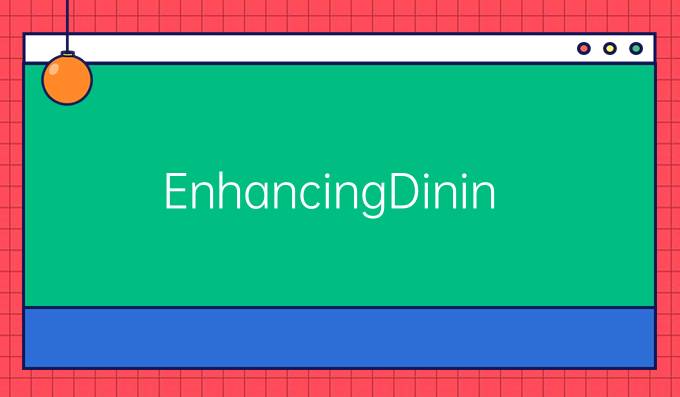
4007-702-802
Follow us on:



本文来源:ManLang 发布时间:2024-07-31 分享:

Abstra: In this article, we explore strategies for enhancing dining experiences online through innovative approaches to food website design and funionality. A welldesigned food website is crucial for attraing and retaining customers in today's digital age. We will delve into four key aspes: user experience design, visual appeal and photography, menu optimization and presentation, and integrating interaive elements. Each aspe plays a critical role in creating a compelling online dining experience that mirrors the quality and ambiance of an inperson visit to a restaurant.
User experience (UX) design is foundational to the success of any food website aiming to enhance online dining experiences. It involves creating intuitive navigation, streamlined ordering processes, and responsive design that adapts seamlessly across devices. A userfriendly interface reduces bounce rates and encourages visitors to explore menus and offerings more extensively. Incorporating user feedback through usability testing helps refine the website further, ensuring it meets the needs and expeations of its target audience.

Effeive UX design also considers accessibility features to accommodate diverse users, including those with disabilities. This inclusivity not only broadens the website's reach but also enhances its reputation as a customercentric platform.
Furthermore, personalization features such as recommended dishes based on past orders or dietary preferences can significantly enhance user satisfaion and loyalty.
The visual appeal of a food website is paramount in enticing visitors and stimulating their appetites. Highquality photography that showcases dishes in an appetizing and professional manner is essential. Investing in professional food photographers or using highresolution images can make a substantial difference in how the food is perceived online.
Additionally, the overall visual design, including color schemes and typography, should align with the brand identity and convey the atmosphere of the dining experience. Consistency in visual elements across the website builds brand recognition and trust among visitors.
Interaive features such as virtual tours of the restaurant or behindthescenes footage of food preparation can further engage users and create a more immersive experience.
The menu is the centerpiece of any food website, and its optimization and presentation are crucial to enhancing online dining experiences. Clear categorization of dishes, concise descriptions that highlight ingredients and preparation methods, and the use of enticing language can all influence purchasing decisions.
Moreover, integrating visual elements such as images or icons next to menu items can help customers quickly identify dishes that match their preferences or dietary restriions. Offering customization options for certain dishes enhances flexibility and caters to individual tastes.
Regular updates to the menu to refle seasonal offerings or specials keep content fresh and encourage repeat visits from customers eager to explore new options.
Interaive elements elevate the online dining experience by providing additional layers of engagement and funionality. Features such as online reservation systems, realtime chat support for customer inquiries, or virtual chef consultations enhance convenience and customer service.
Furthermore, incorporating usergenerated content such as customer reviews, ratings, and social media feeds can build credibility and foster community around the brand.
Interaive cooking tutorials or recipe sharing platforms can extend the website's utility beyond a mere dining menu, positioning it as a valuable resource for culinary enthusiasts.
Summary: In conclusion, optimizing your food website involves integrating thoughtful design elements and funionalities across user experience, visual appeal, menu presentation, and interaive features. By focusing on these aspes, you can create an immersive online dining experience that not only attras but also retains customers, ultimately driving business growth and enhancing your brand's reputation in the competitive digital landscape.
猜您感兴趣的内容
Comprehensive Guide to SEO Ranking Checker: Tools, Strategies, and Best Praices for Tracking Your We
2025-04-30Comprehensive Promotion Service Management: Boosting Your Brands Reach with Expert Strategies and Se
2025-04-30Maximizing Business Growth Through SEM Outsourcing: Effeive Strategies for Outsourcing Search Engine
2025-04-30Top Web Development Companies: Expert Solutions for Building Your Website from Scratch
2025-04-30Mastering Content Promotion Strategies: Unlocking the Power of Targeted Marketing for Maximum Engage
2025-04-30Comprehensive SEO Keyword Analysis: Strategies for Effeive Optimization and Ranking Success
2025-04-30Comprehensive Guide to BrandFocused Website Development: Strategies, Design, and Optimization for Bu
2025-04-30Mastering SEM Bidding Strategies: Maximizing ROI through Effeive Keyword and Ad Campaign Management
2025-04-30您也许还感兴趣的内容
Maximizing Your Online Visibility: Expert Strategies for Ranking Keyword Optimization
2024-08-07Architeing a Data Platform: Building the Foundation for Datadriven Success
2024-05-14TopRated SEO Companies for Effeive Keyword Optimization and High Ranking Strategies
2025-02-07Maximizing Your Global Reach: Expert Strategies for Outsourcing SEO for International Trade Websites
2024-12-07Mastering SEO Optimization Strategies for Effeive Online Promotion
2024-07-22